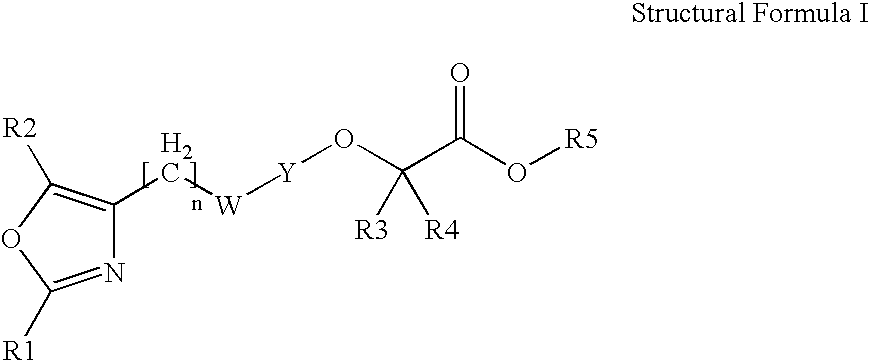Oxazolyl-aryloxyacetic acid derivatives and their use as PPAR agonists
a technology of oxazolyl-aryloxyacetic acid and derivatives, which is applied in the direction of group 3/13 element organic compounds, drug compositions, metabolic disorders, etc., can solve the problems of poor compliance, inadequate insulin repression of lipolysis in adipose tissue, and insufficient insulin activation of glucose uptake, etc., to achieve fewer side effects
- Summary
- Abstract
- Description
- Claims
- Application Information
AI Technical Summary
Benefits of technology
Problems solved by technology
Method used
Image
Examples
example 1
2-Methyl-2-{4-[2-(5-methyl-2-phenyloxazol-4-yl)ethoxy]phenoxy}propionic acid
[0125]
Step A
2-Methyl-2-{4-[2-(5-methyl-2-phenyloxazol-4-yl)ethoxy]phenoxy}propionic acid ethyl ester
[0126]
[0127] A mixture of the toluene-4-sulfonic acid 2-(5-methyl-2-phenyl-oxazol-4-yl)-ethyl ester (See Japan Tobacco Inc International Application WO 9518125) (24 g, 66.9 mmol), 2-(4-hydroxyphenoxy)-2-methylpropanoic acid ethyl ester (See American Home Products U.S. Pat. No. 3,795,691) (12.5 g, 55.71 mmol) and Cs2CO3 (22.7 g, 69.6 mmol) was heated at 55° C. in DMF (45 mL) for 18 h. The reaction was partitioned between EtOAc (160 mL) and H2O (180 mL), and the aqueous phase extracted with EtOAc (150 mL). The combined organic phases were dried (MgSO4) and concentrated under reduced pressure to an oil which was purified by column chromatography (1500 mL SiO2, 10% EtOAc / hexanes to 20% EtOAc / hexanes) to provide 2-methyl-2-{4-[2-(5-methyl-2-phenyloxazol-4-yl)ethoxy]phenoxy}propionic acid ethyl ester (17.8 g, 78%...
example 2
2-{4-[2-(5-Methyl-2-phenyloxazol-4-yl)ethoxy]phenoxy}butyric acid
[0129]
Step A
4-[2-(4-Benzyloxyphenoxy)ethyl]-5-methyl-2-phenyloxazole
[0130]
[0131] 2-(5-Methyl-2-phenyloxazol-4-yl)ethanol [Hulin, et al. J. Med. Chem. (1992) 35(10), 1853-64] (7.42 g, 36.0 mmol), 4-benzyloxyphenol (7.3 g, 36.0 mmol) and triphenylphosphine (9.57 g, 36.0 mmol) were dissolved in anhydrous THF (500 mL) and treated with dropwise addition of diisopropyl azodicarboxylate (7.18 mL, 36.0 mmol). The reaction mixture was stirred at 20° C. for 18 h under a positive-pressure atmosphere of N2. The reaction was partitioned between EtOAc (100 mL) and 0.1 N NaOH (100 mL), and the organic phase washed with water (100 mL) and brine (100 mL). The organic layer was dried with Na2SO4 and concentrated to a residue which was purified by gradient column chromatography (silica column, 100% hexanes to 20% EtOAc / hexanes) to provide a white solid (10.5 g, 76%). Rf=0.3 (10% EtOAc / hexanes) 1H NMR (250 MHz, DMSO-d6) δ 7.86 (d, 2H),...
example 2a
2-{4-[2-(5-Methyl-2-phenyloxazol-4-yl)ethoxy]phenoxy}propionic acid
[0141]
[0142] mp 135° C.; 1H NMR (400 MHz, CDCl3) δ 1.57 (d, 3H, J=6.8 Hz), 2.37 (s, 3H), 2.98 (t, 2H, J=6.4 Hz), 3.73 (s, 3H), 4.20 (t, 2H, J=6.4 Hz), 4.63 (q, 1H, J=6.8 Hz), 6.80 (s, 4H), 7.42-7.45 (m, 3H), 8.00-8.03 (m, 2H); MS (FIA) m / e 368.1 (M+1). 1H NMR (400 MHz, CDCl3) δ 2.28 (s, 3H), 2.87 (t, 2H, J=6.3 Hz), 3.18 (d, 2H, J=6.8 Hz), 3.88-3.97 (m, 2H), 4.63 (t, 1H, J=6.4 Hz), 6.59 (d, 2H, J=9.3 Hz), 6.68 (d, 2H, J=8.8 Hz), 7.13-7.26 (m, 5H), 7.34-7.35 (m, 3H), 7.85-7.87 (m, 2H); MS (FIA) m / e 444.2 (M+1). Anal. Calcd. for C27H25NO5: C, 73.12; H, 5.68; N, 3.16. Found: C, 73.06; H, 5.99; N, 3.25.
PUM
| Property | Measurement | Unit |
|---|---|---|
| Mass | aaaaa | aaaaa |
| Mass | aaaaa | aaaaa |
| Mass | aaaaa | aaaaa |
Abstract
Description
Claims
Application Information
 Login to View More
Login to View More - R&D
- Intellectual Property
- Life Sciences
- Materials
- Tech Scout
- Unparalleled Data Quality
- Higher Quality Content
- 60% Fewer Hallucinations
Browse by: Latest US Patents, China's latest patents, Technical Efficacy Thesaurus, Application Domain, Technology Topic, Popular Technical Reports.
© 2025 PatSnap. All rights reserved.Legal|Privacy policy|Modern Slavery Act Transparency Statement|Sitemap|About US| Contact US: help@patsnap.com



